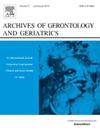Global, regional, and national burdens of hip fractures in elderly individuals from 1990 to 2021 and predictions up to 2050: A systematic analysis of the Global Burden of Disease Study 2021
IF 3.8
3区 医学
Q2 GERIATRICS & GERONTOLOGY
引用次数: 0
Abstract
Purpose
We aimed to analyse the global, regional, and national burdens of hip fractures in older adults from 1990 to 2021, with projections to 2050, on the basis of data from the GBD 2021 study.
Methods
We employed a joinpoint model to analyse trends in the burden of hip fractures from 1990‒2021. The estimated annual percentage change (EAPC) was used to quantify temporal trends over this period. We evaluated the relationship between the social development index and the burden of hip fracture in elderly people and conducted a health inequality analysis. Additionally, we applied Long-short Term Memory (LSTM) networks to forecast burden trends of hip fractures up to 2050.
Results
The global age-standardized incidence rate (ASIR) for hip fractures in older adults rose from 781.56 per 100,000 in 1990 to 948.81 in 2021. The 2021 age-standardized prevalence rate (ASPR) was 1,894.07, and the age-standardized YLD rate (ASDR) was 173.52. From 1990 to 2021, the incidence and prevalence increased by 168.71 % and 173.07 %, respectively, while the burden of DALYs decreased. Future trends were projected via the LSTM. The burden and risk factors for hip fractures varied significantly by sex, country, and region. Population and aging are primary contributors to the rising incidence of elderly hip fractures, with falls being the leading direct cause.
Conclusion
From 1990 to 2021, the global burden of hip fractures in the elderly population, especially among older women, steadily increased. Population ageing highlights the urgent need for targeted public health interventions and resource allocation, including early diagnosis, effective prevention strategies, and region-specific management approaches.

1990年至2021年全球、地区和国家老年人髋部骨折负担及2050年预测:2021年全球疾病负担研究的系统分析
目的:我们旨在分析1990年至2021年全球、地区和国家老年人髋部骨折负担,并根据GBD 2021研究的数据预测到2050年。方法采用关节点模型分析1990-2021年髋部骨折负担的趋势。估计的年百分比变化(EAPC)用于量化这一时期的时间趋势。我们评估了社会发展指数与老年人髋部骨折负担之间的关系,并进行了健康不平等分析。此外,我们应用长短期记忆(LSTM)网络预测到2050年髋部骨折的负担趋势。结果老年人髋部骨折的全球年龄标准化发病率(ASIR)从1990年的781.56 / 10万上升到2021年的948.81 / 10万。2021年年龄标准化患病率(ASPR)为1894.07,年龄标准化YLD率(ASDR)为173.52。1990 - 2021年,发病率和患病率分别上升168.71%和173.07%,DALYs负担下降。未来的趋势是通过LSTM预测的。髋部骨折的负担和危险因素因性别、国家和地区而有显著差异。人口和老龄化是老年髋部骨折发病率上升的主要原因,其中跌倒是主要的直接原因。结论从1990年到2021年,全球老年人髋部骨折负担,尤其是老年女性髋部骨折负担稳步增加。人口老龄化突出表明迫切需要有针对性的公共卫生干预措施和资源分配,包括早期诊断、有效预防战略和针对特定区域的管理办法。
本文章由计算机程序翻译,如有差异,请以英文原文为准。
求助全文
约1分钟内获得全文
求助全文
来源期刊
CiteScore
7.30
自引率
5.00%
发文量
198
审稿时长
16 days
期刊介绍:
Archives of Gerontology and Geriatrics provides a medium for the publication of papers from the fields of experimental gerontology and clinical and social geriatrics. The principal aim of the journal is to facilitate the exchange of information between specialists in these three fields of gerontological research. Experimental papers dealing with the basic mechanisms of aging at molecular, cellular, tissue or organ levels will be published.
Clinical papers will be accepted if they provide sufficiently new information or are of fundamental importance for the knowledge of human aging. Purely descriptive clinical papers will be accepted only if the results permit further interpretation. Papers dealing with anti-aging pharmacological preparations in humans are welcome. Papers on the social aspects of geriatrics will be accepted if they are of general interest regarding the epidemiology of aging and the efficiency and working methods of the social organizations for the health care of the elderly.

 求助内容:
求助内容: 应助结果提醒方式:
应助结果提醒方式:


